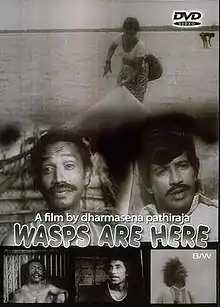Bambaru Avith
Bambaru Avith (The Wasps are Here) (Sinhala: බඹරු ඇවිත්) is a 1978 Sri Lankan Sinhala drama film directed by Dharmasena Pathiraja and produced by director himself with Thilak Godamanne for Saranga Salaroo. It explores tradition and exploitation following the introduction of capitalism to a tiny fishing village and the subsequent clash between the local boss and the urban outsider.[1]
| Bambaru Avith බඹරු ඇවිත් | |
|---|---|
 DVD Cover of film | |
| Directed by | Dharmasena Pathiraja |
| Produced by | Saranga Salaroo |
| Written by | Dharmasena Pathiraja Malini Pathiraja |
| Starring | Malini Fonseka Vijaya Kumaratunga Joe Abeywickrema |
| Music by | Premasiri Khemadasa |
| Cinematography | Donald Karunaratne |
| Edited by | Sextas Aponsu |
Release date | 11 August 1978 |
Running time | 110 minutes |
| Country | Sri Lanka |
| Language | Sinhala |
Plot
The film is set in a fishing village. Anton Aiya is an exploiter who outwardly resembles and acts like a regular fisherman. He feeds off the other fishermen. Into this setting arrives members of the urban entrepreneurial youth. They have adapted to Western Culture, dressing like Westerners and preferring Western music.
Conflict arises between Anton Aiya and Baby Mahattaya (Victor), a representative of the urban youth. A middle-class leftist Weerasena is also of this group. The arrival of these youths has clearly caused a social crisis requiring a solution and all Weerasena can do is stand on a platform and deliver a speech that no one listens to. He finally leaves for the city.
Cast
- Joe Abeywickrema as Anton Aiya
- Vijaya Kumaratunga as Victor, Baby Mahattaya
- Wimal Kumara de Costa as Weerasena
- Malini Fonseka as Helen
- Ruby de Mel as Celestina, Helen's mother
- Amarasiri Kalansuriya as Sanath
- Daya Thennakoon as Francis
- Cyril Wickramage as Cyril
- Somasiri Dehipitiya as Seba
- S. H. Somapala as Christopher
- Piyasena Ahangama as Navy officer
- Daya Alwis as Church father
- W. Jayasiri as Michael
Music
Premasiri Khemadasa composed the music for the film. The two main songs are "Udumbara" and "Handunagathoth Oba Ma."
Awards and nominations
- Sri Lankan representative at 1978 Moscow International Film Festival
- Screened at Mostra and Los Angeles Film Festivals
- Presidential awards for the Best Film and Best Director - 1979
- OCIC awards for Best Film and Best Director - 1979
- Named the fourth Best Sri Lankan Film of the first 50 years by a Presidential council
- Featured in the Cannes Classics 2020 - 4K film and sound restoration was carried out by L’Immagine Ritrovata using the sole-surviving 35mm film positive.
References
- "Moving Images". Czech Business Weekly. 2005. Archived from the original on 2007-09-28. Retrieved 2008-01-05.